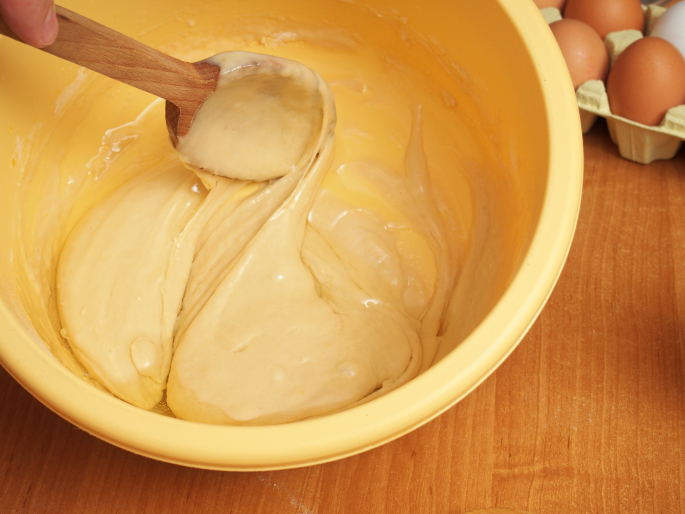
The U.S. Centers for Disease Control and Prevention has a message for anyone eating raw cake batter: Stop.
Health officials have traced a multi-state Escherichia coli (E.Coli) outbreak to cake mix. E.Coli are bacteria found in the environment, food and intestines of people and animals.
As of August 2021, 16 people have been infected with the 0121 strain since February, but experts believe the true number of infections to be much higher.
Seven infections have resulted in hospitalizations, but no deaths have been reported. Which brings ups the question, can you die from raw cake batter?
Here's the truth:
In April 2006, the experience of a 14-year-old who had eaten pancakes made from a mix that had gone moldy was described in the popular newspaper column Dear Abby. The account has since been circulated widely on the Internet as scores of concerned homemakers ponder the safety of the pancake and other baking mixes lurking in their larders.
There is truth to this story, yet its the warning is a little bit deceiving. In a nutshell, expired pancake and other baking mixes pose no danger to you unless:
- You are allergic to mold
- The baking mix was not contained in an unbleached wax paper, plastic, or a foil pouch within its outer packaging
- How old the mix is has no bearing on its safety — a mix that is well within its freshness date yet has come to contain mold spores could prove fatal to someone with a mold allergy, while one that is a year or two beyond its "Best use by" date but did not contain mold spores would be perfectly safe.
But, the underlying claim is very true: it is possible for someone who eats pancakes made from a mix that has sat around too long to suffer a potentially fatal anaphylactic reaction to the molds that have grown therein.
How can this happen? It happened before.
According to Snopes, In 2001, two pathologists practicing in Charleston, South Carolina, reported on an unnamed 19-year-old who died in such a manner. While home on vacation from college, the victim, a young man with a history of allergies (including mold), ate two pancakes made from a packaged mix that had sat open in a kitchen cabinet for about two years. His two friends stopped eating their portions, complaining that the griddlecakes tasted like rubbing alcohol.
MUST READ: The 12 Dirtiest Foods You Are Eating Every Day (And Don't Even Know It)
Very quickly thereafter, while watching television, the college student experienced shortness of breath that was not relieved by his inhaler. He asked his friends to take him to a clinic not far from the home, and he was reported to have turned a bit blue from lack of oxygen (i.e., became cyanotic) during the ride. While he did manage to walk into the clinic on his own, once inside he suddenly collapsed in cardiopulmonary arrest. He failed to respond to resuscitative efforts and was pronounced dead.
The cause of his death was determined to be anaphylaxis due to an allergic reaction to molds.
Anaphylaxis is a rapidly developing immunologic reaction that occurs when those who have allergies come in contact with the substances they are allergic to. When it kills, it does so by triggering fatal respiratory or cardiac arrest.
The pancake mix that delivered a toxic payload was analyzed and found to contain four rather nasty molds: Penicillium, Fusarium, Mucor, and Aspergillus. The decedent had not been allergic to eggs (which are a component of pancakes), so there was no doubt as to which allergy had killed him. It had been mold, and nothing but.
There was a death, and it had been due to ancient pancake mix. Or, rather, to an allergic reaction to the mold that had grown in the stale pancake mix.
Keep in mind there is nothing inherently toxic about pancake mix that has passed its freshness date; the product's aging does not transform it into a poison. Only those who have allergies to mold are at risk, and even...
...then, for the pancake mix to pose a hazard it has to contain mold spores, not just be over the hill.
In October 2008 the pancake mix warning was expanded to include cake, biscuit, and brownie mixes.
For mold to gain access to a food product, the foodstuff has to be exposed to its spores. Pancake mix cocooned in an unbleached wax paper, plastic, or a foil pouch within its outer packaging wouldn't have this contact and should still be safe no matter how old it gets. However, mix sold unpouched in cardboard boxes or paper sacks would likely be at risk even if the box or sack hadn't previously been opened, because such packaging would not necessarily keep dampness out, and mold thrives in damp environments.
What does all this mean? If you don't have a mold allergy, you needn't fear your pancake mix; if you do have such a sensitivity, you shouldn't keep your flapjack makings around for a few years after opening the box or pouch it came in.
So in a nutshell, when in doubt, throw it out.









